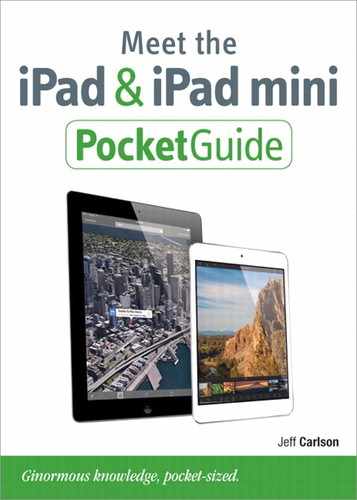Power On and Set Up the iPad
An iPad doesn’t require a computer at all—though one is definitely helpful to have. Apple’s step-by-step getting started process is simple, but you’re prompted to make several decisions about how your data is synchronized and where it will live. (These steps vary a bit depending on how you’re syncing your data and whether you’re upgrading from a previous device. For example, if you begin connected to a computer, you select a Wi-Fi network after selecting an existing device profile.) But the process is easy to follow, so don’t worry if these steps don’t match your experience exactly. If you’ve already done this stage, skip ahead to “iPad Essentials.”
1. To power the iPad on for the first time, press and briefly hold the button at the top of the iPad until the Apple logo appears.
2. Slide the “Slide to set up” slider to get started.
3. Choose your language and region.
4. Tap the name of a nearby Wi-Fi network and enter its password to get online. Tap Join.
5. On the Location Services screen, tap Enable Location Services. This option allows apps such as Maps to use data related to your whereabouts. You can choose to disable Location Services if you’re concerned about privacy, but that limits the functionality of many things, such as Find My iPad. (You can enable or disable the option later in the iPad’s settings, too.)
6. Choose whether to set up the device as a new iPad or to restore data from an iCloud or iTunes backup, and then tap Next.
• To set up a new iPad, you’ll need to enter an Apple ID (or create a new one if you don’t have one). The Apple ID is what you normally use to buy media from iTunes, the App Store, or the Mac App Store.
• For iCloud, you’ll need to enter your iCloud user name and password. Then, choose the latest saved backup and tap Restore. After the data is restored, see step 7 and then you’re done.
• For iTunes, you’ll need to connect a sync cable between the iPad and the computer running iTunes. In iTunes, choose the name of the device you want to use as the backup source. The iPad will restart, and iTunes will sync the settings and content from the backup to it. You will then need to repeat some of the setup steps.
7. Review the Terms and Conditions for using the iPad, and agree to them by tapping the Agree button.
8. Create a four-digit passcode. It’s not required, but I highly encourage you to use a passcode.
9. If you want to use Siri, tap Use Siri.
10. If you want Apple to receive anonymized usage data and diagnostic information in the event something crashes, tap the Automatically Send button in the Diagnostics screen. If you’d prefer not to share the data, tap Don’t Send.
11. Lastly, tap the Start Using iPad button to finish setup.
Tip
If you already have a lot of apps for your iPhone or iPod touch, iTunes may want to transfer them all to the iPad. Instead of deselecting unwanted apps one by one, do this: In the Apps tab in iTunes, Command-click (Mac) or Control-click (Windows) one app’s checkbox to deselect them all. Click Apply to make the change. Then, go through the list and enable the apps you want to transfer.
Note
I own an iPhone, which goes with me everywhere. Because my iPad acts as an extension of all of my important data, I chose to use the data from my iPhone the first time I set up an iPad instead of configuring it from scratch. If you take this route, you’ll still need to do some cleanup work; I found that some universal iPad apps (ones which can run on either an iPhone or the iPad) did not transfer automatically, but otherwise the process was smooth.
